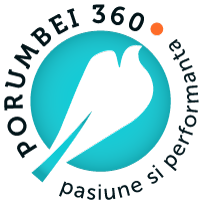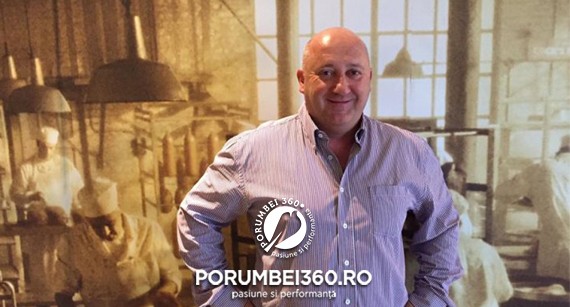Marc de Cock is the manager of a successful meat company, "Charles", formerly known as "Cock's Vleesaren". And we can say that Marc's long career as a pigeon fancier is also a success.
I met many breeders who became champions. However, being a successful pigeon fancier in the long run is a whole other story. And this is Marc's greatest quality. He amazed his fellow pigeon fanciers season after season with sensational results, which inevitably led to numerous titles.
Short history
It all started with and thanks to his grandfather, Charles, a true sprinter, who had won more than 1 place. He used to focus on one pigeon, which at the end of the week got the 1st place and also earned money on top. This is where Marc began to develop a passion for pigeons. And the grandfather helped him, building the first aviary for his nephew, and Marc took action. Thus began the career of a living legend.
Marc competed with his father, Jozef, in a successful tandem between 1976 and 1998, thanks to successful investments: two class pigeons, "Dokus" and "Schellensduiven", as well as other specimens from Jan Broecks' farm. They also bought Marien Pieterse's "167" and this was a turning point in his career. He has been raising pigeons in the aviary located on the Brandstraat since 1999 and the first big star was De Crack, from Marcel Dillen's farm in Ranst. This pigeon had a phenomenal record. Nationally, he placed 9th KBDB Fund, also winning the “Gouden Oscar” and “Gouden Ring” extreme marathon titles in the Waasland region. It was also the 3rd provincial KBDB Fund, with 14 stages ranked in total. Marc also bought Rambo, another pigeon from Marcel Dillen's collection. This specimen proved to be an excellent breeder. 1994 was the year when Het Kanon climbed to the top, being the 1st place Nat. Bourges of 12,389 pigeons. And in 2000, another 1st place was entered in the palmares, this time from Narbonne.
Marc also competed in international pigeon races. For example, he won the car offered as a prize in two editions of the famous One Million Dollar Race in South Africa. And in 2000 he also won the Olympic race in Kaapstad.
Marc has made some spectacular investments throughout his career. For example, he bought the whole family of Raw-Sablon pigeons in 2002 with his friend Erik Limbourg. But he also really wanted to win an Olympic title one day, and the coveted trophy was won in 2006 with the Special Man pigeon. He was Olympic champion in Dortmund in 2009. He was also the 6th place Nat. KBDB Fund 2008 and 4th place "Golden Ring" fund in the same year. Then the 1st place Club Lokeren Fund and the 104th place Nat. Barcelona of 11,484 pigeons, 246th place St. Vincent of 7,515 pigeons.
Let's take into account the phenomenal NIQ (BE06-4140181). It ranked 104th Nat. Barcelona out of 11,484 pigeons. Meanwhile, her sister Leen (BE08-4255148) ranked 1st Int. Narbonne 2010.
When Erik Limbourg's total auction took place in 2009, Marc then bought the most expensive pigeon ever sold in a public auction: Eagle Eye. This exceptional pigeon was the 4th place Nat. KBDB All-round Olympic champion and champion (General).
Marc also owned an ace pigeon in 2015: Johan 275 (BE12-4313275), who was 3rd place Nat. KBDB Fond, at the provincial level occupying the 1st place KBDB Fond 2015. In the Pipa ranking of the same year, the respective pigeon occupied the 1st place out of 5 background stages, and today he is the grandfather of the 7th place in the Thailand Grand Prix final and the 2nd place As-pigeon One Loft Special 2018.
Another Olympic pigeon created by Marc was Bold Eagle (BE14-4068054), participant in the 2017 Olympics, winner and 13th place Nat. KBDB Fond Maturi in 2016. The pigeon climbed the first step of the podium “Golden Ring” Fond in 2016, and in 2015 it was awarded a silver medal in the same competition. Bold Eagle is also the father of several top pigeons, such as 711/17, 18th place Nat. Aurillac of 3,886 pigeons, and of 165/17, 22nd place Nat. Chateauroux of 5,209 pigeons.
The 2019 season was similar to the one in 2018, accumulating 20 (!) Victories. One of them was the 1st place Tulle, doubled by the 2nd place Souillac. And the icing on the cake was 4th place Nat. KBDB Fond, title obtained by the red male Double Remco (BE18-4164005).

This male also won the “Gouden Ring” in the Fond category in 2019. Here is what the top of the rankings in 2018 looks like, as a chick:
Bourges:
Club 1/599
Prov. 28 / 4,900
Nat. Zone 272 / 7,514
Nat. 1138 / 23,854
Chateauroux:
Club 20/291
Prov. 219 / 3,206
Nat. 1611 / 17,281
2019 record:
Souillac:
Club 1/85
Nat. Zone 2 / 1,164
FVOV 10/911
Nat. 29 / 4.056
Tulle:
Club 1/81
Nat. Zone 1 / 2,085
FVOV 21 / 1,353
Nat. 62 / 7,155
Aurillac:
Nat. 227 / 3,584
Nat.Zone 75 / 1,009
Meanwhile, Marc has already ticked over 100 (!) Provincial victories. And let's not forget that his farm supplies top genetic material to other breeders. For example, Jos Thoné, who achieved beautiful results with his Kirin, a female who comes from the 801 Aelbrecht line. Kirin has already obtained 10 places out of 1, including the 1st place Nat. Brive.
Male widows, females and chicks
Marc starts the season with a team of 50 widowed males, about 40 widowed females, 200 chicks and about 35 breeding pairs. The pigeons are mated at the end of November and raise the first series of chicks. A second series of chickens no longer exists. The first training sessions take place at the beginning of April. Weather permitting, and widows are taken up to 60 km for 14 days. Males and females are left together 30 minutes before boarding. After the contest, the partners stay together until the next day. The training takes place in the morning, between 7:00 and 8:30, and the pigeons are obscured from January to May. Marc approached the method of the classic widow, although he has a few tricks up his sleeve to motivate his pigeons even more.
Females flying to widowhood are also mated at the end of November and can hatch for 5 days. They also do not have the second series of chickens and are separated in April, after which they start training up to 60 km. Participates in stages over distances between 200 and 1000 km. Couples do not stay together for more than 5 minutes before boarding. Upon arrival, we can stay together until the next morning. Females do not mate with each other and this is due to the cylindrical rollers installed on the floor, which prevent the pigeons from settling. Females are not obscured.
Chick contests are not Marc's main goal. The over 200 chicks are reproduced in 3 series and are weaned at the age of 21 days. Males and females are kept together. The chicks are obscured from January to June 21, after which they receive additional light until the end of the season. The chicks train only once a day, immediately after the widows. Follow the same training regimen. The sliding door is introduced towards the end of June, and the males are kept separate from the females during boarding. They are taken to training 3 times a week, after which the partners can stay together for half an hour. No other method of motivation applies.
Repeating the cycle
Temse pigeons receive a combination of BEYERS Superdiet and Long Distance mix. Most of these pigeons are boarded weekly, the cross-country skiers being boarded every 2 or 3 weeks. Pigeons that are employed in the marathon stages are an exception, as they are boarded at most once every 3 weeks. The groundbirds that arrive from the race on Saturday receive a mixture of "Long Distance" food from BEYERS, and in electrolyte water. The same pigeons are fed on Sunday, Monday and Tuesday with 100% Superdiet mixture. In the water, they are given the following products: two days of electrolyte and Zyma Herb, another two days of electrolyte and Wonder Pigeon, another two days of electrolyte, then garlic juice and tea for another two days. After that the program returns on day 1. The pigeon feed consists of 50% sports mix and 50% super diet mix on Wednesday, Thursday, Friday, Saturday and Sunday. On the day of boarding, additionally, a handful of hazelnuts.
The man in the white robe
The vet goes to the aviary every month. The pigeons are given a tablet against trichomoniasis or yellow drops after each stage in which they spent two nights in the car. Last season, they did not receive anything against respiratory infections because they did not affect the pigeons. If the pigeons have to stay in the car for several days in the heat, then they are given an Appertex tablet (against coccidiosis). As a result of the strict selection process, there is almost no case of eye cold among the chicks. And in the rare cases when adeno-coli breaks out, it takes only a few days until proper treatment begins to take effect.
A grandiose construction
The first floor of this prestigious farm is 70 meters long and is the place where mature flyers and chicks are housed. Above the flight compartments are the reproduction ones, which extend over a length of 40 meters. The remaining 30 meters are used as office and work space.
Above the flight compartments is a huge gabled roof that provides adequate ventilation and plenty of fresh air. Each compartment has a ventilation tube to ensure air circulation. The farm is equipped with underfloor heating, to which a hygrometer is added to obtain a pleasant temperature and permanently dry air. Underfloor heating is used all year round. The speakers in each compartment are equipped with a conveyor belt, and the pigeons sit on wooden grills. Darkening can be set automatically and there are automatic blinds, so the windows can be left open day and night in the hot summer months. This farm also has a rigorous cleaning standard and also has a perfume particle evacuation system. The façade of the flight section is provided with several landing hatches along its entire length and 60 Bricon antennas are mounted, so that each arrival is recorded accordingly.

Pigeon Palace in Temse
The final selection
The initial flight team consists of about 90 mature and yearling pigeons and about 30 (30%) of them pass the selection test. The pigeons are selected exclusively based on the results, so they must perform well at the provincial and national level if they want to stay on board. All puppies left after the competitions will be part of the flight team. The selection starts only when they become yearlings. Marc likes pigeons that look average in the hand, but look smart and focus only on their results. And don't you agree that an ugly pigeon looks better and better as its performance gets better?
Close inbreeding, such as father x daughter or mother x son, is often applied to obtain products intended for the queen compartment, although an even harsher selection is applied here because this method obtains many qualitatively inferior birds. Marc's strain is largely based on De Raw-Sablon / Aelbrecht pigeons: Eagle Eye, Bold Eagle and Johan. And in Rockefeller's line, 1st place Nat. KBDB General 2018 recently invested. The team has every reason to be extremely ambitious next season, targeting national championships, ace pigeon titles and, why not, a national victory. Each season, Marc relies on the support of caregivers Luc Buyl and Andre Moonens.
The 2018 season was an extraordinary one for “ROCKEFELLER” BE17-4094340, he winning the 1st place Nat. KBDB General.
The top rankings look like this:
Narbonne
Club 3/97
Prov. 29/624
Nat. 92 / 3,017
Limoges
Club 1/154
Prov. 77 / 2,138
Nat.Zone 28 / 2,510
Nat. 187 / 7,236
Brive
Club 1/40
Prov. 23/811
Nat.Zone 4 / 1,187
Nat. 72 / 4,384
Chateauroux
Club 11/434
Prov. 65 / 5,209
Nat.Zone 206 / 8,486
Nat. 569 / 27,081
Bourges
Club 3/303
Prov. 55 / 3,886
Nat.Zone 61 / 6,920
Nat. 266 / 19,133
Vierzon
Club 6/357
FVOV 170 / 3,854
Author: Bart Nies
Text and photo source: pipa.be



 TEXT
TEXT

 VIDEO
VIDEO
















Comentarii articol
Nu sunt comentarii pentru acest articol.